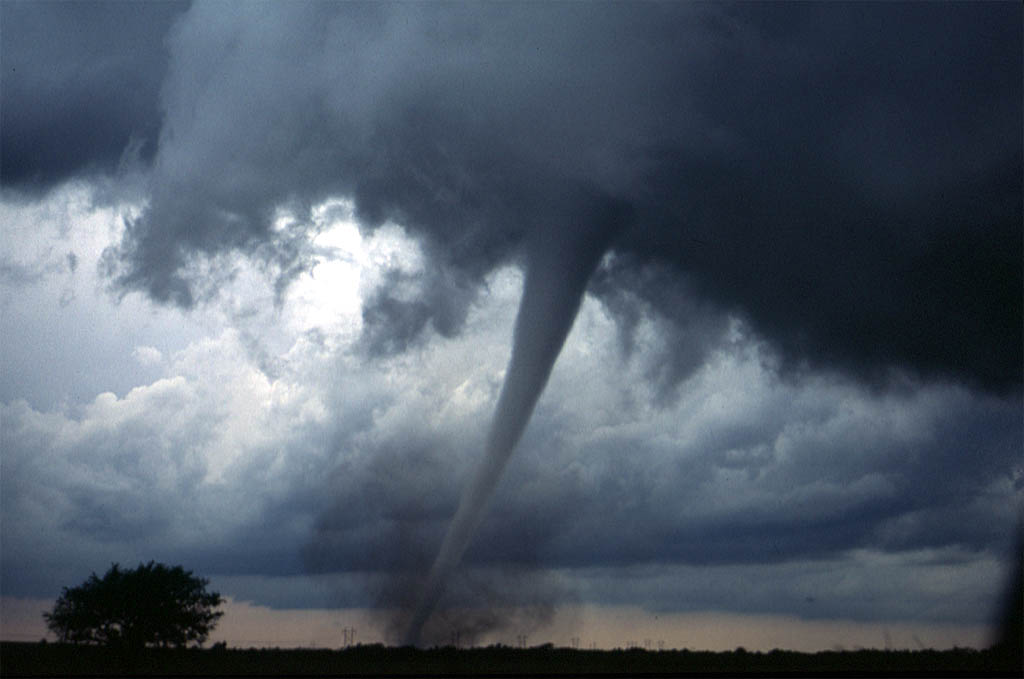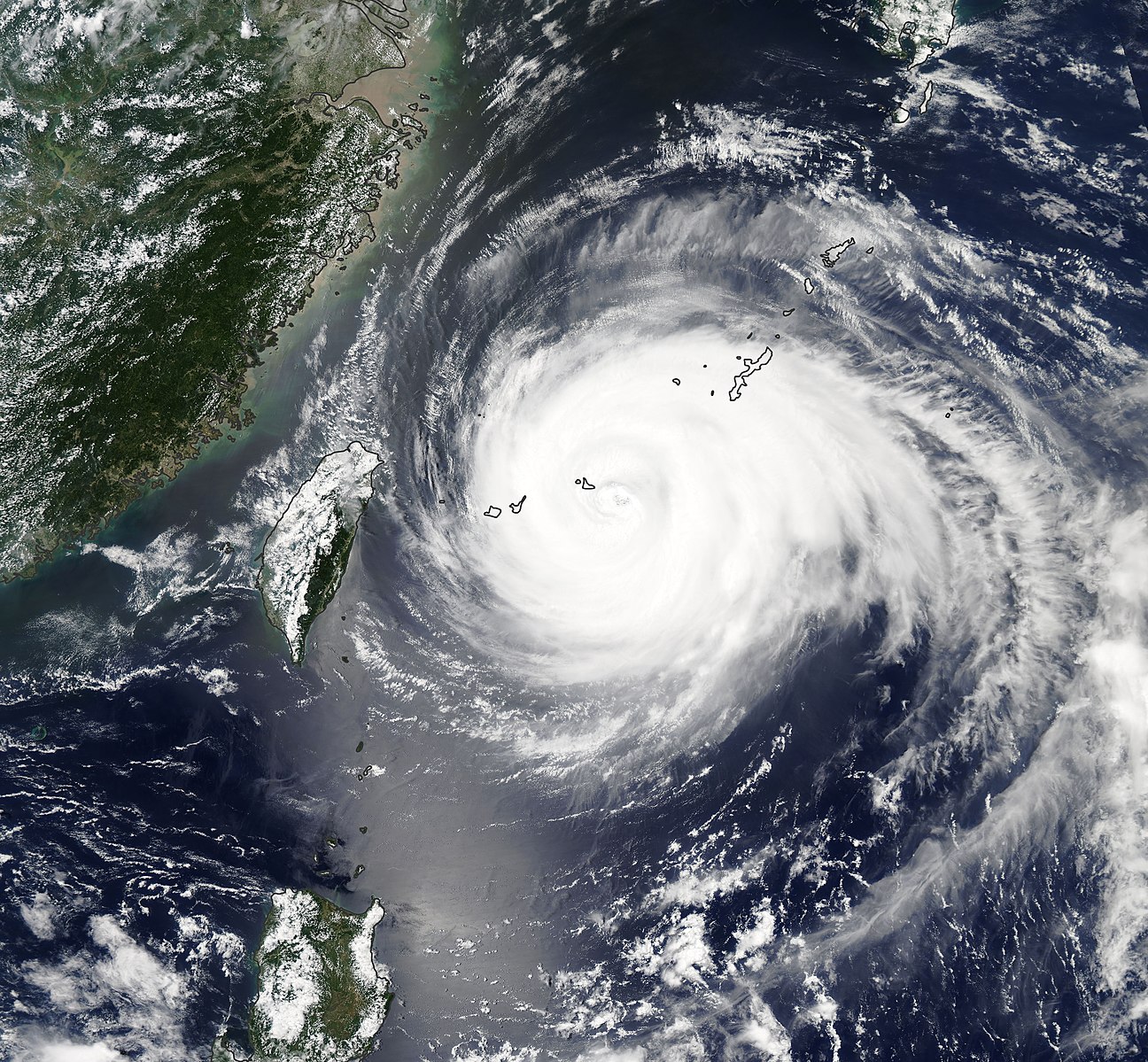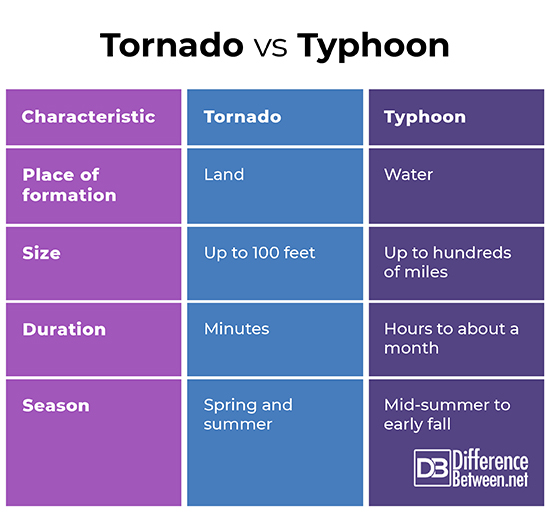Difference Between Tornado and Typhoon
What is a Tornado?
A tornado is a rapidly spinning column of air that forms from powerful thunderstorms. Tornadoes are found on every continent, including surprising places which include England, New Zealand, and the islands of Japan. The place where tornadoes are most frequent is the United States, particularly in the Midwest and the Southeast.
Genesis of a tornado
Tornadoes usually occur in hot, humid areas, especially during the spring and summer months in the northern hemisphere. Tornadoes form during thunderstorms. Most thunderstorms do not produce tornadoes, but some have the right combination of collisions between hot, humid air and cold air that they form into supercells which can form into tornadoes.
Typically, a thunderstorm will form when humid air and cold air mix, creating rotating columns with powerful winds. These columns are initially horizontal, but the warm air creates an updraft causing one of these columns to become vertical. On either side of the updraft, two more columns form, the largest of which leads to the thunderstorm. If the wind is sufficiently powerful and creates an updraft, a regular thunderstorm can become a supercell. About 30% of supercells produce tornadoes.
Tornado characteristics
Tornadoes can be a few feet across or up to a hundred feet across and have winds with speeds of up to 100-200 miles per hour or more at their most deadly.
Most tornadoes last no longer than ten minutes, although some can last a half-hour. The longer-lived tornadoes tend to be the more destructive kind. Tornadoes are some of the most destructive weather disturbances that occur on land, but they are also rare.
Tornado distribution
Most tornadoes that occur worldwide occur in the United States, mostly in the middle and southeastern portions of the country. Some of the most destructive tornadoes, however, take place in the southern great plains. Tornadoes occur on every continent. Europe is also known for occasional tornadoes. They tend to not be as powerful as those in the United States, though a tornado in Luxembourg injured 19 people and caused significant damage to houses, automobiles, and electrical infrastructure on Friday, August 9, 2019.
Although England is small and has only about 34 tornadoes per year, it has the largest number of tornadoes per square kilometer of any country in the world. Most of these tornadoes occur in the Thames Valley near London. Overall, most European tornadoes occur in southern Europe, such as Greece and Italy, where cold, relatively dry mountain air collides with moist warm air from the Mediterranean.
In Asia, tornadoes are common in eastern India during monsoon season and in Bangladesh because of its moist climate and flat terrain. Tornadoes are particularly problematic in Bangladesh where housing tends to be poorly constructed. Africa has relatively few tornadoes, but one location where hurricanes are common are parts of South Africa.
What is Typhoon?
Typhoons are severe tropical cyclones that occur in the northwest Pacific in the vicinity of the south coast of China, the Philippines, Taiwan, and Japan. They form near the equator and travel to higher latitudes. Typhoons occur all over the world and are referred by different names depending on where they form. In the Atlantic and east Pacific, for example, they are called hurricanes.
How typhoons form
The general term for the storm referred to as a typhoon in northwest Pacific is a tropical cyclone. Tropical cyclones form along the equator as air is blown across warm water. Typhoons only form in waters that are about 80 degrees Fahrenheit down to 165 feet of water depth. Air circulates over warm water and water vapor condenses into clouds. Eventually, this combination can create a rotating storm system. The weakest type of tropical storm system is called a tropical disturbance. Once the wind speed in the tropical disturbance surpasses about 22 miles per hour, the tropical disturbance becomes a tropical depression.
Once the wind speed is faster than 38 miles per hour, the tropical depression becomes a tropical storm. The tropical storm, once it forms, will move away from the equator. In the case of a typhoon, it moves north. Once the wind speed in the storm reaches 74 miles per hour or greater, it is classified as a typhoon if it occurs in the northwest Pacific.
Typhoon characteristics
Typhoons are typically hundreds of miles wide and have windspeeds that can be over 157 miles. Typhoons are classified according to their windspeed. The weakest typhoons or hurricanes are category 1, the weakest of which have windspeeds of 74 miles per hour. The typhoons are category 5 with a windspeed of 157 miles per hour or more. In the northwest Pacific, typhoons with windspeeds of 150 miles per hour or greater are designated super-typhoons. The most destructive storm labeled a typhoon was Typhoon Haiyan which struck the Philippines and other parts of Southeast Asia and the northwest pacific in 2013. It killed 6,000 people and injured 30,000 others. Because of the climatic conditions of the northwest Pacific, there is no typhoon season. They can occur at any time though most of them occur in the later summer and early fall of the northern hemisphere in July and November.
Similarities between Tornado and Typhoon
Tornadoes and typhoons are both storms formed by rapidly rotating storm systems created by warm, humid air rising as it collides with cold air. They also tend to occur in warm, moist regions. Tornadoes and typhoons are also known for being enormously destructive.
Differences between Tornado and Typhoon
Although there are many similarities between tornadoes and typhoons, there are also significant differences. These differences include the following.
- Tornadoes form over land, whereas typhoons form over water.
- The largest tornadoes are hundreds of feet across, while the largest typhoons are hundreds of miles across.
- Tornadoes tend to last for a few minutes to a half-hour, while typhoons can last for anywhere from 12 hours to a about a month.
- Tornadoes are most common in the spring and summer in most places, while typhoons generally occur in the mid-summer to early fall, although they can happen at any time during the year.
Tornado vs. Typhoon
Summary
Tornadoes are rotating air funnels created by rising air. They form out of thunderstorms and are found on every continent. They generally occur in warm, humid areas where cold air is coming into contact with warm, moist air. Typhoons are tropical cyclones that occur in the Northwest Pacific. They form from air circulating over warm water leading to rotating storms. They are called by different names depending on where they occur in the world. Tornadoes and typhoons are similar in that they are both rotating low-pressure storms systems created by warm rising air and they both form in warm humid areas. They are also known for being very destructive. They differ in that while tornadoes form over land and tend to be a few hundred feet across at the most, typhoons form over water and tend to be hundreds of miles across.
- Difference Between Environmental Performance Index and Development - November 24, 2023
- Difference Between Environmental Intervention and Development - November 8, 2023
- Difference Between Eco Efficiency and Eco Effectiveness - September 18, 2023
Search DifferenceBetween.net :
Leave a Response
References :
[0]Image credit: https://commons.wikimedia.org/wiki/File:Maria_2018-07-10_Aqua_MODIS.jpg
[1]Image credit: https://en.wikipedia.org/wiki/Tornado#/media/File:Dszpics1.jpg
[2]Al Jazeera. “Just How Common Are Tornadoes in Europe?” News | Al Jazeera, Al Jazeera, 11 Aug. 2019, https://www.aljazeera.com/news/2019/08/common-tornadoes-europe-190811105500162.html
[3]Oswald, Ed. “What Country Has the Most Tornadoes in the World?” Weather Station Advisor, 1 July 2019, https://www.weatherstationadvisor.com/what-country-has-the-most-tornadoes/.



